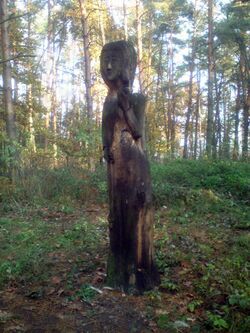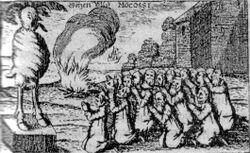Mokosh
Topic: Religion
 From HandWiki - Reading time: 4 min
From HandWiki - Reading time: 4 min
This article's factual accuracy is disputed. (July 2020) (Learn how and when to remove this template message) |
| Mokosh | |
|---|---|
Goddess of Mother Earth, fertility, fate, harvest, moisture, sexuality, patroness of women, children, childbirth, home, weaving. | |
 Modern wooden statue in the Czech Republic | |
| Symbol | sheep, spider and Linden |
| Personal information | |
| Consort | Perun and Veles (assumption) |
| Children | Jarilo[citation needed] and Morana[citation needed] |
| Equivalents | |
| Greek equivalent | Gaia, Demeter |
| Roman equivalent | Terra, Ceres |
| Christian equivalent | Paraskeva Friday |
Mokosh (Template:Lang-orv) is a Slavic goddess mentioned in the Primary Chronicle, protector of women's work and women's destiny.[1] She watches over spinning and weaving, shearing of sheep,[2] and protects women in childbirth. Mokosh is the Mother Goddess.[3]
Mokoš was the only female deity whose idol was erected by Vladimir the Great in his Kiev sanctuary along with statues of other major gods (Perun, Hors, Dažbog, Stribog, and Simargl).
Etymology and origin
The etymology is uncertain. Max Vasmer suggests that her name is derived from the same root as Slavic words mokry, 'wet', and moknut(i), 'get wet', or 'to dive deeply into something'. She may have originated among the northern Finno-Ugric peoples who worship the divinity Moksha.[citation needed]
Myth
Family relations
According to ancient Slav belief, this deity had some connection to thunder god Perun.[4]
Her consorts are probably both the god of thunder Perun and his opponent Veles. In saying, the former Katičić follows Ivanov and Toporov (1983) without further corroborating their claim.[5] Katičić also points to the possibility that as goddess Vela she is the consort of Veles, and might even be interpreted as another form of the polymorph god Veles himself.[5]: 167–198 Mokosh is also the mother of the twin siblings Jarilo and Morana.[citation needed]
A key myth in Slavic mythology is the divine battle between Perun and Veles. Some authors including Ivanov and Toporov believe the abduction of Mokosh causes the struggle.[lower-alpha 1][6]
Later worship
As late as the 19th century, she was worshipped as a force of fertility and the ruler of death. Worshipers prayed to Mokosh-stones or breast-shaped boulders that held power over the land and its people.[7]
In Eastern Europe, Mokosh is still popular as a powerful life-giving force and protector of women. Villages are named after her. She shows up in embroidery, represented as a woman with uplifted hands and flanked by two plow horses.[8] She has been claimed to be shown with male sexual organs, as the deity in charge of male potency, however no visual proof has been provided.[9]
Christianization
During the Christianization of Kievan Rus', she was replaced by the cult of the Virgin Mary and St. Paraskevia.[10][11]
Archeological evidence
Archeological evidence of Mokosh dates back to the 7th century BC.[12]
Boris Rybakov, in his 1987 work Paganism of Ancient Rus,[13] conjectures that Mokosh is represented on one of the sides of the Zbruch Idol.
Legacy
In toponymy
Scholarship considers that traces of Mokosh exist in the toponymy of Slavic countries:[14][15][16]
- Slovenia: a village name Makoše (in the vicinity of Ribnica, historically known as Makoša or Makoš); river name Mokoš (Prekmurje region);
- Croatia: village Makoše near Dubrovnik; suburb areas of Nova and Stara Mokošica;
- Czech Republic: village and river name Mokošín (in Pardubice Region, Eastern Bohemia);
- Bosnia and Herzegovina: hill name Mukušina (near Ravno village); hill name Mukoša (South of Mostar);
- Polabian: place name Muuks/Mukus;
- Poland : Mokosz, Mokosza, Mokoszyn, Mokosznica;
- Russia : Old Russian village Mokošina;
- Belarus : marsh named Mókšava balóta.
See also
- Kikimora
- Perperuna and Dodola
References
- ↑ Ivanits, Linda J. (February 15, 1989). Russian Folk Belief. M.E. Sharpe. ISBN 9780765630889. https://books.google.com/books?id=-s36xYcqG1EC&q=mokosh+goddess&pg=PA16.
- ↑ Miriam R. Dexter, Marija Gimbutas (2001). The Living Goddesses. University of California Press. pp. 197, 206–208. ISBN 9780520229150. https://books.google.com/books?id=7DfI39EDbMcC&dq=Slavic+goddess+shearing+of+sheep&pg=PA206.
- ↑ Katičić, Radoslav (2003). Die Hauswirtin am Tor: Auf den Spuren der großen Göttin in Fragmenten slawischer und baltischer sakraler Dichtung. Frankfurt am Main: PETER LANG. p. 40. ISBN 3-631-50896-4. http://www.peterlang.com/detail/buch/35057/5/50896/.
- ↑ Brlic-Mazuranic, Ivana. Croatian tales of long ago. Translated by Fanny S. Copeland. New York: Frederick A. Stokes Co.. 1922. p. 257.
- ↑ 5.0 5.1 Katičić, Radoslav (2010). Gazdarica na vratima: Tragovima svetih pjesama naše pretkršćanske starine. Zagreb: IBIS GRAFIKA. pp. 209–210. ISBN 978-953-6927-59-3. http://www.matica.hr/knjige/816/.
- ↑ Евдокимова, Светлана; Evdokimova, Professor of Slavic Studies and Comparative Literature Chair Department of Slavic Studies Svetlana (July 26, 1999). Pushkin's Historical Imagination. Yale University Press. ISBN 0300070233. https://books.google.com/books?id=Ha2hlK0volAC&q=Mokosh&pg=PA216.
- ↑ Patricia Monaghan (2010). "[1]". Encyclopedia of Goddesses and Heroines p. 516
- ↑ Ivanits, Linda J. (February 15, 1989). Russian Folk Belief. M.E. Sharpe. ISBN 9780765630889. https://books.google.com/books?id=-s36xYcqG1EC&q=mokosh+&pg=PA16.
- ↑ Hubbs, Joanna (September 22, 1993). Mother Russia: The Feminine Myth in Russian Culture. Indiana University Press. ISBN 0253115787. https://books.google.com/books?id=fVQz3I4FCWUC&q=mokosh&pg=PA20.
- ↑ Vyacheslav Ivanov, Vladimir Toporov. Mokoš./ В. В. Иванов, В. Н. Топоров - «Мокошь». Мифы народов мира, т. II. М.:Российская энциклопедия, 1994.
- ↑ Patricia Monaghan, PhD (1 April 2014). Encyclopedia of Goddesses and Heroines. New World Library. pp. 306–. ISBN 978-1-60868-218-8. https://books.google.com/books?id=Cj5OAwAAQBAJ&pg=PA306.
- ↑ Harald Haarmann (2008). "[2]". Introducing the Mythological Crescent: Ancient Beliefs and Imagery p. 98
- ↑ Boris Rybakov (1987). "Святилища, идолы и игрища" (in ru). Язычество Древней Руси (Paganism of Ancient Rus). Moscow: Nauka. http://historic.ru/books/item/f00/s00/z0000030/st003.shtml.
- ↑ Češarek, Domen (2016). "Mala gora pri Ribnici – mitološko izročilo v prostoru (Mala Gora (Little Mountain) by Ribnica – Cosmic myth in mythical landscape)". Studia mythologica Slavica 19: 135. doi:10.3986/sms.v19i0.6619. http://sms.zrc-sazu.si/pdf/19/SMS_19_06_Cesarek.pdf.
- ↑ Katičić, Radoslav. "Gospa Međugorska i mokra Mokoš" [Unsere liebe Frau von Međugorje und die nasse Mokoš]. In: Ethnologica Dalmatica br. 19 (2012): 10-11. https://hrcak.srce.hr/107497
- ↑ Blažek, Václav. "Celto-Slavic Parallels in Mythology and Sacral Lexicon". In: Studia Celto-Slavica 1 (2006): 80. DOI: https://doi.org/10.54586/TVGF2195.
Notes
- ↑ Although Ivanov and Toporov nowhere quote original sources indicating that fact. Compare: Katičić (2010):210
 |
 KSF
KSF
